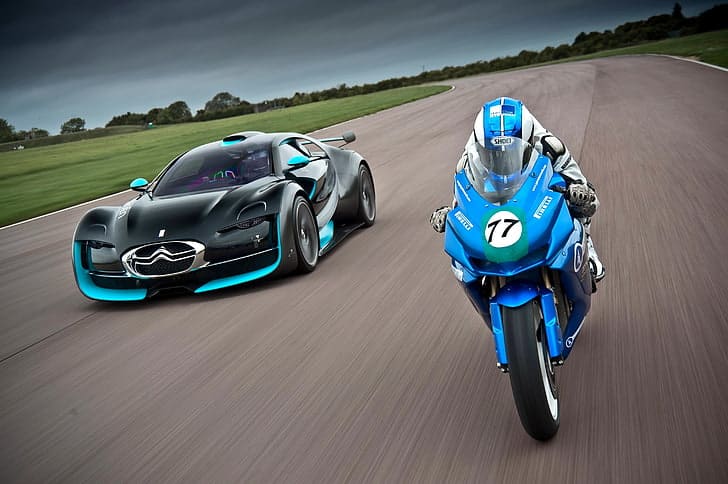When it comes to choosing a mode of transportation, motorcycles and cars are among the top choices for many individuals. While they both serve the primary purpose of providing mobility, the experience, risks, and insurance needs associated with each are significantly different. This is particularly evident when comparing “Motorcycle Insurance vs Car Insurance.” Both types of insurance are designed to offer financial protection against accidents, theft, and other unforeseen incidents, but the specifics of coverage, cost, and factors influencing premiums vary considerably.
Understanding these differences is crucial for vehicle owners to ensure they have the appropriate coverage for their needs. In this blog post, we will delve into the nuances of “Car vs Motorcycle Insurance,” exploring the main differences between the two and providing insights to help you make an informed decision about which type of insurance is best suited for your vehicle.
Motorcycle vs Car Insurance:
Motorcycles are often perceived as riskier than cars due to their open and lightweight nature, which exposes riders to a higher risk of injury in case of an accident. This perception influences how insurance companies assess risk and, consequently, how they set insurance premiums. On the other hand, cars, being more substantial and enclosed, generally offer better protection to their occupants and are seen as less risky in certain aspects. However, the cost of repairing or replacing a car can be higher than that of a motorcycle, which is a significant factor in insurance calculations.
The choice between “Motorcycle Insurance vs Car Insurance” also reflects the owner’s lifestyle, usage patterns, and personal preferences. Motorcycle enthusiasts often view their ride as a symbol of freedom and adventure, but this comes with specific insurance considerations that differ from the more standard and everyday use of cars. Therefore, it’s not just about comparing costs but also about understanding the unique aspects of coverage that each vehicle type requires.
As we dive deeper into the comparison of “Car vs Motorcycle Insurance,” we’ll explore various aspects such as the differences in coverage options, the factors influencing insurance costs, the impact of location and usage, and tips for choosing the right policy. This information will be invaluable for both current and prospective owners of motorcycles and cars, providing them with the knowledge needed to navigate the complexities of vehicle insurance.
Exploring the Main Differences Between Motorcycle Insurance and Car Insurance
Coverage Differences
One of the key areas where “Motorcycle Insurance vs Car Insurance” diverges is in the scope and type of coverage offered.
- Liability Coverage: Both motorcycle and car insurance typically include liability coverage, which is mandatory in most states. However, due to the higher risk of serious injury in motorcycle accidents, riders often need higher liability limits.
- Collision and Comprehensive Coverage: While both types of insurance offer these coverages, the cost to repair or replace a motorcycle can be significantly different from that of a car. Motorcycles are generally less expensive than cars, but certain high-end models or custom bikes can be costly to insure.
- Uninsured/Underinsured Motorist Coverage: This is crucial for motorcycle insurance due to the higher risk of injury. Motorcyclists are more vulnerable in accidents, especially those involving uninsured or underinsured motorists.
- Medical Payments/Personal Injury Protection: Given the higher risk of injury for motorcyclists, this coverage is more significant in motorcycle insurance than in car insurance.
- Accessories and Custom Parts Coverage: Motorcycles often have custom parts and accessories that require additional coverage. Car insurance policies generally don’t need to account for such extensive customizations.
Risk and Premium Factors
The factors that influence the premiums for “Motorcycle Insurance vs Car Insurance” are somewhat different:
- Risk of Accident and Injury: Motorcycles are considered riskier due to their open nature and the higher likelihood of injury in an accident. This risk is often reflected in higher insurance premiums for motorcycles.
- Vehicle Value: Cars generally have a higher base value than motorcycles, which can lead to higher comprehensive and collision coverage costs.
- Riding Season: Motorcycle riding is often seasonal, which can impact insurance rates. Some insurers offer “lay-up” policies where certain coverages are suspended during off-season months.
- Mileage: Cars are typically used more frequently and for longer distances than motorcycles. Higher annual mileage can increase the cost of car insurance.
Impact of Location and Usage
Location and usage significantly affect “Car vs Motorcycle Insurance” costs:
- Geographical Location: Areas with higher traffic volumes, inclement weather, or higher crime rates can see increased insurance rates for both motorcycles and cars. However, the impact can be more pronounced for motorcycles due to their vulnerability.
- Usage: Motorcycles used primarily for leisure may have lower insurance rates compared to those used for daily commuting. In contrast, cars used for commuting generally have higher insurance costs than those used occasionally.
Tips for Choosing the Right Policy
When comparing “Motorcycle Insurance vs Car Insurance,” it’s important to consider your specific needs and usage patterns. Ensure that you have adequate liability coverage and consider factors like the value of your vehicle and your riding or driving habits. Shopping around and comparing quotes from different insurers can also help you find the best coverage at the most competitive rate.
Conclusion: Navigating the Choice Between Motorcycle and Car Insurance
In summarizing the comparison between “Motorcycle Insurance vs Car Insurance,” it’s evident that while both share fundamental insurance principles, they diverge significantly in terms of coverage needs, risk assessment, and cost factors. For prospective and current owners, understanding these differences is crucial in making an informed decision that aligns with their specific requirements, lifestyle, and budget.
Motorcycle insurance, characterized by its attention to the unique risks associated with riding, often necessitates higher liability limits and greater consideration for personal injury protection. The vulnerability of motorcyclists on the road, coupled with the potential for seasonal usage, demands a more tailored approach to insurance. On the other hand, car insurance, catering to a vehicle that is typically used more frequently and for a variety of purposes, focuses on a broader spectrum of coverage that accounts for higher vehicle value and mileage. Factors such as geographical location, usage patterns, and individual risk profiles play a significant role in shaping the insurance policies for both motorcycles and cars.
Choosing the right insurance policy, be it for a motorcycle or a car, requires a comprehensive evaluation of several factors. This includes understanding the different types of coverage available, recognizing the intrinsic risks associated with the vehicle, and considering the frequency and nature of its use. It’s also important for vehicle owners to actively shop around, comparing quotes and policies from different insurers to find the best fit. Insurance is not just a legal requirement but a crucial aspect of responsible vehicle ownership, offering financial protection and peace of mind.
Ultimately, whether opting for “Motorcycle Insurance vs Car Insurance,” the goal is to secure a policy that provides adequate protection without unnecessary costs. By carefully considering the unique aspects of each vehicle type and one’s personal needs, vehicle owners can ensure they are well-equipped to handle the unforeseen, keeping their focus on the enjoyment and convenience that comes with owning a motorcycle or a car.



